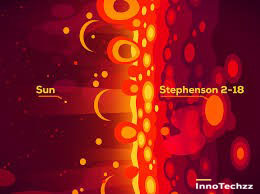Stephenson 2-18. What is Stephenson 2-18, it's type and size. UY SCUTI vs Stephenson 2-18.

In the constellation Scutum, Stephenson 2-18 (St2-18) is a red supergiant. It's also known as Stephenson 2-DFK 1 and RSGC2-18, and it's the world's biggest star, with a diameter of 2,150 times that of the Sun. At a distance of 18,900 light years from Earth, the star may be found. It's part of the Stephenson 2 open cluster.
Star type
Stephenson 2-18 is an M6 spectral type red supergiant. With a radius of 2,150 solar radii, it is one of the biggest stars ever found.
It's also one of the brightest red supergiants ever discovered. It glows with roughly 440,000 solar luminosities with a surface temperature of 3,200 K.
Size
The estimated radius of Stephenson 2-18 is 2,150 solar radii. It would stretch past the orbit of Saturn (1,940 – 2,169 R) if it replaced the Sun in our solar system. The size of the star equates to a volume 10 billion times that of the Sun.
MY Cephei, in the constellation Cepheus, has a radius of 2,061 times that of the Sun, while WY Velorum, in the constellation Vela, has a radius of 2,028 solar radii.
Stephenson 2-18 compared with UY Scuti
Stephenson 2-18 surpassed the previous record holders, the red supergiants WOH G64 in the constellation Dorado and UY Scuti in the constellation Scutum, as the biggest known star. WOH G64 is far smaller than both St2-18 and the current runner-up, MY Cephei (2,061 R), with an estimated radius of 1,540 to 1,730 solar radii.
Until more accurate measurements of the star's parallax in the Gaia Data Release 2 yielded a lower distance and thus lower values for the star's luminosity and radius, UY Scuti had an estimated radius of 1,708 solar radii. UY Scuti's estimated radius is currently only 755 solar radii, which is comparable to Antares (680–800 R) but smaller than Betelgeuse (887 R), Mu Cephei (972–1,260 R), VY Canis Majoris (1,420 R), and HR 5171A (1,060–1,160 R).
Location
Stephenson 2-18 is part of the open cluster Stephenson 2, which covers 1.8' of sky but is not visible with amateur telescopes. Because it is severely hidden by dust, the cluster cannot be seen in visible light, but it may be viewed in infrared light. It is located between Alpha and Beta Scuti in the sky.
Last updated: Jun 11, 2022
Posted By InnoTechzz